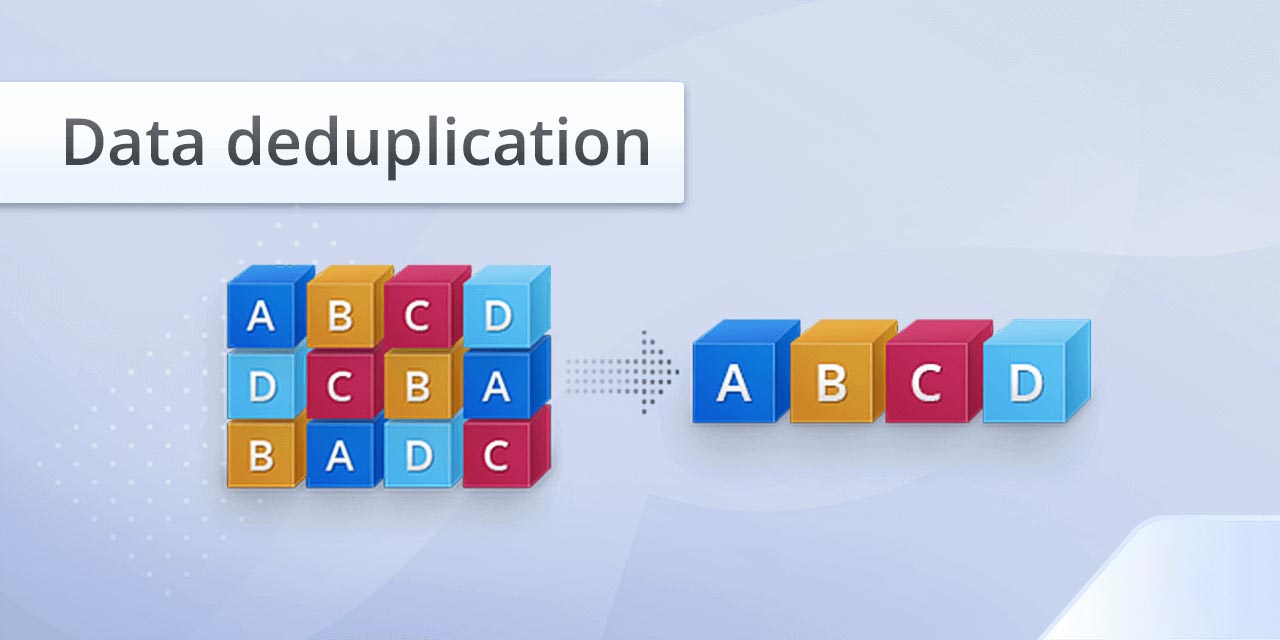Data Deduplication: What is it?
Backup technology has seen a huge number of advancements over the past couple of decades, but few have been as significant as the development of data deduplication. Data deduplication, which removes duplicates of data entries to save storage space, has been around in some form since the 1970s. At that time, redundant data was identified by clerks who went through the data line by line, manually searching for duplicates. In the years since then, as quantities of data have grown exponentially, the process has become automated. Data growth is so rapid nowadays that even the newest storage solutions struggle to keep up – which is why data deduplication is more important than ever. As a managed services provider (MSP), understanding what data deduplication is and how it works can help you optimize your storage capacity, saving you significant amounts of money in the long run.
What is Data Deduplication?
Data Deduplication, or Dedup for short, is a technology that can help lower the cost of storage by reducing the impact of redundant data. Data Deduplication, when enabled, maximizes free space on a volume by reviewing the data on the volume and looking for duplicated portions. Duplicated portions of the dataset of a volume are only stored once and (optionally) compacted to save even more space. Data Deduplication reduces redundancy while maintaining data integrity and veracity.

How does it work?
Data deduplication works by correlating various data sets or files to identify duplicates. Moreover, data deduplication occurs on two measures file and sub-file. Further, data deduplication generates a data fingerprint unique to each file or object. It certainly analyzes the data to detect unique data sets before storing them.
Therefore, once it identifies the duplicate data, it eliminates them. It then replaces references and pointers to save the unique data. It also assigns a distinct number to identify each data set. As a result, it removes the duplicate data using the distinct number.
Above all, data deduplication is a process that runs in the backend. It is also a simple technique that reduces the usage of storage resources and their costs. Most importantly, it scans data sets completely to reduce any duplication. It also ensures that there is no loss of data in the process. Data Deduplication can also transpire from the backend process. Moreover, the technique identifies the correlation between data sets. It also transfers the right information to the applications.
What are the advantages?
Backup Capacity
There is far too much redundancy in Backup Data, especially in full backups. Even though incremental backups only back up modified files, some redundant data blocks are invariably included. That’s when Data Reduction technology like this shines. A Data Deduplication device can help you locate duplicate files and data segments within or between files, or even within a data block, with storage requirements that are an order of magnitude lower than the quantity of data to be saved.
Continuous Data Validation
There is always a risk associated with logical consistency testing in a primary storage system. The block pointers and bitmaps can be corrupted if a software bug causes erroneous data to be written. If the file system is storing backup data, faults are difficult to identify until the data is recovered, and there may not be enough time to repair errors before the data is recovered.
Higher Data Recovery
The Backup Data Recovery service level is an indicator of a backup solution’s ability to recover data accurately, quickly, and reliably. Complete Backups and Restore are faster than incremental backups because incremental backups frequently scan the entire database for altered blocks of data, and when recovery is required, one full backup and numerous incremental backups must be used, which slows down recovery.
Backup Data Disaster Recovery
For backup data, Data Deduplication has a good capacity optimization capability; doing a full backup every day requires only a small number of disc increments, and it is the data after capacity optimization that is transmitted remotely over WAN or LAN, resulting in significant network bandwidth savings.

Is Data Deduplication safe?
Data deduplication can be safe as long as certain vulnerabilities and weaknesses are accounted for. Some of these include:
- The integrity of the file system: With some solutions, a file system is used to run the process. This file system needs to be shielded from viruses and other threats using a solution like a next-generation firewall (NGFW), for example.
- The integrity of the index: The various pointers that tell the system to reference the original data where the copy used to be are kept within an index. This index needs to be protected from corruption.
- In-place upgrades: You have to ensure your deduplication system still functions after software or hardware gets updated. Otherwise, the deduplication process may not work well with the updated version of the software or hardware.
- Many systems still require a tape backup: As you accumulate more and more data, older data may bog down your system – even with a deduplication system in place. At this point, it would still be advisable to store older files on a tape-based system.
Deduplication use cases
Deduplication is useful regardless of workload type. Maximum benefit is seen in virtual environments where multiple virtual machines are used for test/dev and application deployments.
Virtual desktop infrastructure (VDI) is another very good candidate for deduplication because the duplicate data among desktops is very high.
Some relational databases such as Oracle and SQL do not benefit greatly from deduplication, because they often have a unique key for each database record, which prevents the deduplication engine from identifying them as duplicates.
Why is Data Deduplication important?
Data deduplication is important because it significantly reduces your storage space needs, saving you money and reducing how much bandwidth is wasted on transferring data to/from remote storage locations. In some cases, data deduplication can reduce storage requirements by up to 95%, though factors like the type of data you are attempting to deduplicate will impact your specific deduplication ratio. Even if your storage requirements are reduced by less than 95%, data deduplication can still result in huge savings and significant increases in your bandwidth availability.
There is no single right way to engage in data deduplication. Luckily, many different variables can help you find the best approach for your environment. From inline to post-processing to target to source deduplication, there are a variety of approaches that can all result in significant decreases in your storage capacity needs. This, in turn, results in significant cost savings for your organization.

Conclusion
As organizations expand their businesses, managing large volumes of data becomes crucial for achieving the desired efficiency. Data Deduplication powers stakeholders and management to handle their data in the best possible way.